|
AnnaLee Foster
Driscol,
Winner
of the All Ireland Fleadh Cheoil, 2010
An
interview on YouTube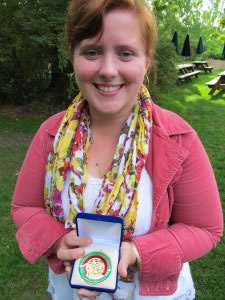
Having known Annalee for almost 10 years (we met when she
was still a teenager), I have watched her grow and learn so much
in the world of harping. Last summer, when I heard she won the Fleadh
Harp Competition, I was so thrilled for her! I wanted to hear all
about it, so we sat down one
morning over coffee and talked about her experience.
I guess a good first question is what got you started on
the harp and when?
When I was a senior in high school, a friend invited my family to go
to a Christmas
concert by a Seattle harpist, Bronn Journey. As I watched him
play Irish tunes on a lever harp I just sort of had a flash, “Hmm,
I can do that.” I
expressed my interest to my parents about wanting to learn how to play
the harp, so for my graduation present from high school, they bought
me a William Rees Glenn Aulen harp and said, “OK,
let’s see how you do.” I took my first harp lesson with
Jewel Shield, and that was the beginning to the end of the story. My
current harp is a Thormahlen Ceili-Mor which is what I used to win
the Fleadh Competition.
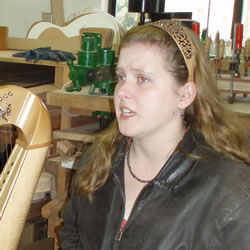 Do you play other instruments? Do you play other instruments?
My
mom always said that I was singing and dancing before I could walk
or talk. When I was 8, I convinced my parents that I needed to learn
to play piano. I had some pretty iffy teachers back then. The first
teacher didn’t seem to be much
farther ahead of me in playing skills. She moved away and I got another
teacher at 12 who said I was too old to start learning Mozart. So I
learned a lot of American folk tunes, nothing serious. I also played
clarinet in elementary band, and I was active in ensemble, choir,
and drama. I’ve always been around music, but not until I was
in high school did I get serious about it. It took me a while to find
the right instrument.
How did you get interested in Irish music?
I’ve always loved Irish music and have been interested in it
since I was 5. In fact I
listened to Thistle and Shamrock with Fiona Ritchie on OPB radio every
Saturday night
at 6:00. I made a pact with myself when I was 5 that I would go to
Ireland and learn to
speak Irish. I’ve gone to Ireland but haven’t learned how
to speak yet.
You attended The Irish Harp Center studying with Janet 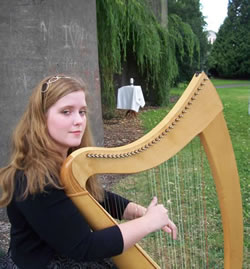 Harbison. Tell
us about Harbison. Tell
us about
your experience there.
When I got involved with Irish music on the harp, it became
my passion. I learned about the Irish Harp Center in a roundabout
way by attending a workshop with Grainne Hambly on one of her Northwest
tours. It opened my eyes to the possibilities of the harp and I absolutely
loved it. I went online and learned about a workshop on the east coast
of Ireland called Cairde Na Cruite, which means The Friends of the
Harp. (http://www.cairdenacruite.com/Home.html )
I went there for a weeklong workshop in August where I had my first
real immersion in learning by ear. It was a complete shock as before
that I was learning mostly by sheet music and a little bit by listening.
At this workshop, there was no such thing as sheet music until the
end of the day after you already had your head crammed with 10 tunes.
Coming away from that experience, I knew that I really wanted to study
the harp and get serious about Irish music.
In 2005, when I was 23, I went online again to see where the best
place to study would be
and I came upon the website for Janet Harbison (http://www.irishharpcentre.com/),
whose name sounded really familiar. By coincidence later that week,
I was listening to
one of Grainne’s CDs and in her liner notes she happened to thank
her teacher, Janet
Harbison. I was able to connect that Janet Harbison was the director
of the Belfast Harp
Orchestra which was on one of my favorite CDs, Celtic
Harpestry, and that she was the
composer of my absolute favorite harp compositions, Earth, Water, Wind
and Fire. It was
a big circle. The person who started me on my serious quest for Irish
music, Grainne,
brought me back to her teacher, Janet, and when I realized that this
person taught Grainne
how to play like she does, I said, “I have to go to that person.”
 Being at the Irish Harp Center was the hardest 2 years of my life but
also the best. Being at the Irish Harp Center was the hardest 2 years of my life but
also the best.
Basically, you ate, drank, and slept harp. There wasn’t a lot
of time for “a life”. Other students said it was so intense,
and what about having a real life? When I heard that, I said, “Don’t
you realize what you signed up for? This is your life for the next
however many years that you’re here. This is your life.” Not
only do you get private lessons with Janet, you also get instruction
on Irish Harp History, which is tied in with Irish history, which
is tied in with Irish political history. So basically, you’re
learning a lot about the sociology of Irish traditional music and how
it fits in with Irish culture. You’re sort of becoming a little
bit of an ethno musicologist. It’s very comprehensive.
You’re also being taught how to teach. I would observe
Janet’s
teacher students, and I
would also teach my own students, assist with group teaching and music
appreciation
classes, and it was just so much fun.
We would also go once a week to the local children’s school for
the handicapped to do
palliative music. Then there were rehearsals for the Irish Harp Orchestra,
which was the
professional orchestra, and the National Harp Orchestra, which was
a training orchestra,
where some of the members were as young as 8 years old. These girls
really knew how to
play. There were a couple of boys, too, who were very, very talented.
Always more girls
than boys because of the way the history of the harp evolved and survived.
In the ancient
days, the professionals in the Irish Harp World were mostly men. There
were a couple of
female professionals. I’m sure there were more, but of the recorded
history that we have,
we know of two. After the ancient Irish wire strung harp died out and
the rise of the gutstrung
harp took over in the Egan era of the1800s, there were many unsuccessful
tries to
revive the old style of Irish harping. The nuns in the convent preserved
the harps that they
had, and learning to play the harp became one of the accomplishments
for young, refined,
marriageable women. That’s actually where Janet learned to play
the harp, in an Irish
speaking Catholic convent school in Cork. It was run by nuns and they
had a harp room
and a harp class. At that time they were mostly taught to sing and
accompany their voice
with the harp. Her teacher taught people like Moire O’Hara (http://www.maryohara.co.uk/)
and some of the other 50s and 60s
Irish Cabaret singers.
When I was in the Irish Harp Orchestra, I traveled to Belgium,
France, Germany, Austria,
Cypress, Tennessee, and Ireland with the orchestra. We also played
at wedding events. So
there was plenty of practical experience as well as learning. It was
like an apprenticeship.
I have heard you talk about the vision you have of a harp
school in Portland, Oregon. 
Tell us about that.
My goal is to build, in America, something similar to what
Janet has in Ireland. People from all over Ireland come to study with
Janet. She’s one of
the best teachers! I would one day like to aspire to be as good a teacher
as Janet. I would love to foster a school of Irish traditional music,
playing music on the lever harp, at such a standard that people really
realize how versatile it is. I want us to be just as numerous as guitar
players. Your time at the Harp Center was part of preparing for the
All Ireland Championship, what did you do more currently to prepare.
What was the Competition like?
First of all, I had to decide what I wanted to play because unlike
a lot of other
competitions, they don’t dictate what your repertoire is supposed
to be. They don’t tell you what to play. They give you a guideline
of accepted styles of tunes. You can play a jig, reel, hornpipe, air,
slow air, mazurka, fling, etc.
Part of the judging for the adjudicators, is seeing what kinds of tunes
you choose, which
tunes you choose, how you arrange and ornament them, how you put your
own flavor
into the tune and still make each tune individual while keeping it
traditional. The level of
competition was very high - some of the players were oozing with talent
- so for me to get
the honor of champion, in some ways, I still can’t believe it.
The standards were very
high. They look at your musicality, your technique, your ability to
take a tradition and
make it your own, creative and new, but still keep yourself tethered
to the tradition
without going into left field. It’s a big balancing act.
 Did you get to watch the other people in the competition? Did you get to watch the other people in the competition?
I was able to watch the 12-15 year old competition and
the 15-18 year old competition. Also in my own competition, I was smack
dab in the middle so I got to hear what went before me and what came
after me.
What ran through your mind? Did you wonder, maybe I should play this
one first instead or that one, or I shouldn’t play that tune?
No I didn’t. I basically spent the year leading
up to the Fleadh, consciously thinking about what tunes I wanted to
play. The tunes I pick have to grab me.
What tunes did you play?
When I chose my tunes, I first decided what categories I was going
to play. I always try
to play a jig and a reel. They’re like the gold standard in Irish
music. The newest tune I
played was a reel composed by the fiddler, Edward Reavy, called Love
at the Endings.
Some of his tunes have been ingrained into the tradition and others
are more obscure in
keys that are less common and thus less accessible. Another tune was
a 6-part jig, the
Stray Away Child, composed and played by fiddler from Sligo, Michael
Gorman. I heard
it on Thistle and Shamrock and I knew it was one I needed to play.
I also chose a slow
air, Blind Mary, by Turlough O’Carolan and a hornpipe, the Ahane,
which is actually the
name of a town near where I lived in Ireland. It is an absolutely charming
hornpipe.
Did anyone else play the tunes you chose?
Nope, not in my competition. I think one of the younger competitors
also played Blind
Mary.
What is the format to the competition?
You basically sit down and play your first piece, wait for the judges
to nod to you that
they’re ready for your next piece. You play your next tune and
so forth. When you’re
done, you get up and walk away. You can announce your pieces if you
like, but you don’t
have to. You’re basically telling the audience and adjudicators
who you are as a musician
by the flow of your program, how you carry the energy of the music
and how you craft it.
That’s what they’re looking for.
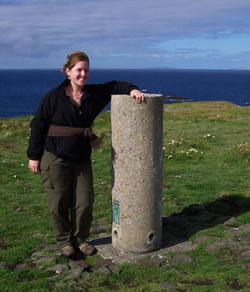
How many were in your competition?
There were 12. They are chosen through county and regional
competitions. There are 4 regions in Ireland: Ulster in the north,
Connacht in the east, Munster in the south, and Leinster in the west.
The top 2 from each of those competitions go to the Fleadh. I qualified
through the competition in Chicago earlier this year. And there is
another Fleadh on the American east coast.
What was it like while you were playing? Did you feel
like you were doing well?
Yes and no. You’re always your own worst critic.
If you feel like you’ve made a minor mistake, you’re right
on top of it. I can get very nervous. But I felt like I played the
best I ever played in competition. Ultimately, I’m really in
competition with myself, not with the other participants. I did think, “Oh
maybe I could have played that better,” but in leading up to
my competition, I did all the preparation I could do, I practiced as
hard as I could, and it’s just a matter of how I play on that
day. The adjudicators make a difference too in how they feel about
the music you play. They might not like your style, or think you’re
too traditional or too modern or too this or too that. I think of harp
competition as more like running track. Track is a team sport, but
you’re really
not competing against the other people, you’re competing against
yourself. At the Irish Harp Center they have examinations that graduate
you to different levels. There are adjudicators for that as well. I
got high distinctions in all of my exams and these helped prepare me
for competing. I think competitions are more stressful than examinations.
There’s
more on the line. If I play my best, do the best I can, play the best
I’ve ever played
in competition then I’m happy. If I don’t win, it’s
not the end of the world. I’ll
still be able to teach, I’ll still be able to perform and I can
go back to Ireland and try again. Now that I’ve won, I don’t
feel like I need to compete again.
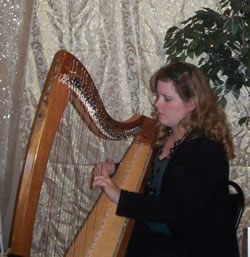 What
was going through your head during the announcements of the winners,
especially after they named the 3rd and 2nd place winners and neither
one of those was you? What
was going through your head during the announcements of the winners,
especially after they named the 3rd and 2nd place winners and neither
one of those was you?
The
person who got third was a gentleman from Cork by the name of Fierkra.
He played gorgeously and was very creative. He was a very gripping
and dynamic
performer. My friends and I thought he would get first place, so when
he got 3rd, I figured there was no way I was going to place. Then Deirdre
Neverdran from Claire, got 2nd. I thought, “She deserves
that, she played very well and she’s
a good solid player.” At that point I was thinking, “Okay,
if Fierkra got 3rd and Deirdre got 2nd, who’s getting first?
When they announced my name, my first reaction was, “What!” Then
it sunk in and I walked to the front for my medal. It was surreal.
I still can’t
believe it. It was a very strict and hard competition.
Did Janet watch you compete?
Janet was at the Fleadh event the week before the actual
competition teaching some workshops, but during the competition, she
was visiting her husband’s
parents in England. There were a few other students of hers in the
younger divisions. I was her only student that won that year.
As a teacher, what is your approach to teaching the harp?
It’s
about having fun in a way that won’t hurt your body.
The age group makes somewhat of a difference. I have a few students
that are around 5-7 years of age. With them, and actually with all
of my students, if you’re not having fun, you’re
doing it wrong. It’s also about expanding your horizons. At a
young age, I teach them the tools to arrange for themselves. We start
with the straightforward chord choices but then I show them some chord
options and substitutions and let them decide what sound
they like. You start with a place of comfort and then talk about what
other things you can do. By the time they’re done playing the
tune, it’s their arrangement.
We’ll block the chords, we’ll run the chords, we’ll
walk the chords, play with the voicings of the chords, but in the end
they get to choose how they fit it all together. And also as they advance,
I give them ideas for ornamentation or tasteful ways to play around
with the rhythm so they are empowered by the music they’re learning.
As they progress, they can go back and revisit the simple arrangements
they had at the very beginning and gain tools to expand on it, so they
can take something simple and embellish it, flush it out so it develops
as they progress 3 or 4 years down the line.
So having fun is one thing, expanding horizons is another, empowering
the students to
think for themselves musically is another. I don’t want to produce
clones and I don’t want
to produce harpers that only play fixed arrangements.
And forget about perfect. Practice makes easy not perfect.
No matter how difficult it is at the beginning, the more you do it,
the easier it gets. With me, the tunes that give me the biggest struggle
to learn, I like to play the most. It gives me the most sense of accomplishment.
I’m a bit driven, and I tend to thrive on the
drama of deadlines. I like to surmount challenges. I used to mountain
climb and to get to the top you have to go over some big obstacles.
Then when you get to the top, you’ve got that
high of “I made it.” Then you realize there’s another
mountain to climb. It’s
the same type of idea. Knowing where your student is and breaking down
an insurmountable challenge by saying, “Ok, we can get here and
now that we’ve gotten here, see that over there?
Let’s see if we can do that. OK, we’ve done that but we’re
still not done.”
I think music should be fun but I also believe in being
firm about having good technique and that there’s a method to
the madness. There’s a way
we do certain things to
encourage healthy posture and healthy technique. Janet says, as far
as fingering goes, “simple fingerings for simple shapes.” Breaking down the
tune, if the phrase happens
more than one place, do the fingering the same way. If it worked the
first time, it’ll work
the second time. If you change the ornamentation, you might need to
change things
around, but keep it simple. You don’t have to be fancy.
Do you do the same thing with your older students?
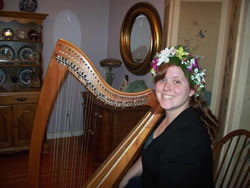 Basically,
yes, although the repertoire will be different. With the younger kids
we’ll do more nursery rhyme type tunes and they sometimes make
up their own verses. One of my favorites was a verse made up to What
Can You Do With a Silly Sailor? (I changed it from Drunken Sailor.)
A little girl who loves Disney said, “Put
him in a dress and call him Cinderella.” I get them writing their
own verses. There are some nonsense tunes that Janet composed for some
of her younger students. One of them is the Castle Connell Train. They
learn a walking bass line left hand melody with a boom chuck right
hand while singing and making up their own verses about what they’ll
do and see at the train station. I just love teaching the little ones. Basically,
yes, although the repertoire will be different. With the younger kids
we’ll do more nursery rhyme type tunes and they sometimes make
up their own verses. One of my favorites was a verse made up to What
Can You Do With a Silly Sailor? (I changed it from Drunken Sailor.)
A little girl who loves Disney said, “Put
him in a dress and call him Cinderella.” I get them writing their
own verses. There are some nonsense tunes that Janet composed for some
of her younger students. One of them is the Castle Connell Train. They
learn a walking bass line left hand melody with a boom chuck right
hand while singing and making up their own verses about what they’ll
do and see at the train station. I just love teaching the little ones.
Do you have recommendations for beginners? Intermediates?
Get a teacher. Don’t necessarily settle for the first teacher
you find. Shop around and find
a teacher that will teach what and how you want to learn. If you can’t
get a teacher, you
can try Skype. I would recommend going to workshops on the topics that
interest you. Go
to harp conferences. Get input from as many people as you can. Listen
to other musicians
than harp players. Listen to the fiddlers, accordion players, singers,
pipers, whistle and
flute players, who are playing the tunes you want to learn. How they
interpret a tune will
be different from how a harper might interpret that same tune. Listening
will give you
ideas. You might not be able to do what they do, but it can inspire
something new for
you. It doesn’t matter if it’s Paraguayan, Irish, Balkan,
or Breton music. Listen to the
sources. With the Internet, you can hear a lot of great stuff. CD Baby,
that’s your best bet.
If you can, travel to the area where the music you like is popular
and immerse yourself in
it.
Thank you so much Annalee for talking with me, and congratulations
on winning
the All Irish Fleadh 2010! Sharon Thormahlen
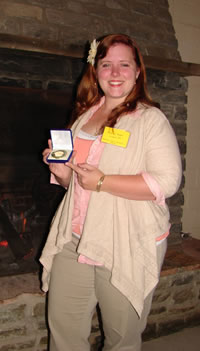
|
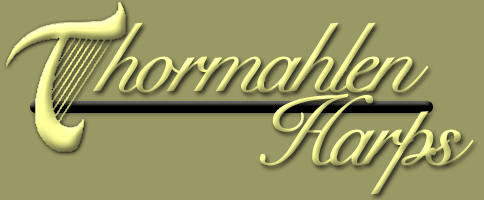

 Do you play other instruments?
Do you play other instruments? Harbison. Tell
us about
Harbison. Tell
us about Being at the Irish Harp Center was the hardest 2 years of my life but
also the best.
Being at the Irish Harp Center was the hardest 2 years of my life but
also the best.
 Did you get to watch the other people in the competition?
Did you get to watch the other people in the competition?
 What
was going through your head during the announcements of the winners,
especially after they named the 3rd and 2nd place winners and neither
one of those was you?
What
was going through your head during the announcements of the winners,
especially after they named the 3rd and 2nd place winners and neither
one of those was you?
 Basically,
yes, although the repertoire will be different. With the younger kids
we’ll do more nursery rhyme type tunes and they sometimes make
up their own verses. One of my favorites was a verse made up to What
Can You Do With a Silly Sailor? (I changed it from Drunken Sailor.)
A little girl who loves Disney said, “Put
him in a dress and call him Cinderella.” I get them writing their
own verses. There are some nonsense tunes that Janet composed for some
of her younger students. One of them is the Castle Connell Train. They
learn a walking bass line left hand melody with a boom chuck right
hand while singing and making up their own verses about what they’ll
do and see at the train station. I just love teaching the little ones.
Basically,
yes, although the repertoire will be different. With the younger kids
we’ll do more nursery rhyme type tunes and they sometimes make
up their own verses. One of my favorites was a verse made up to What
Can You Do With a Silly Sailor? (I changed it from Drunken Sailor.)
A little girl who loves Disney said, “Put
him in a dress and call him Cinderella.” I get them writing their
own verses. There are some nonsense tunes that Janet composed for some
of her younger students. One of them is the Castle Connell Train. They
learn a walking bass line left hand melody with a boom chuck right
hand while singing and making up their own verses about what they’ll
do and see at the train station. I just love teaching the little ones.